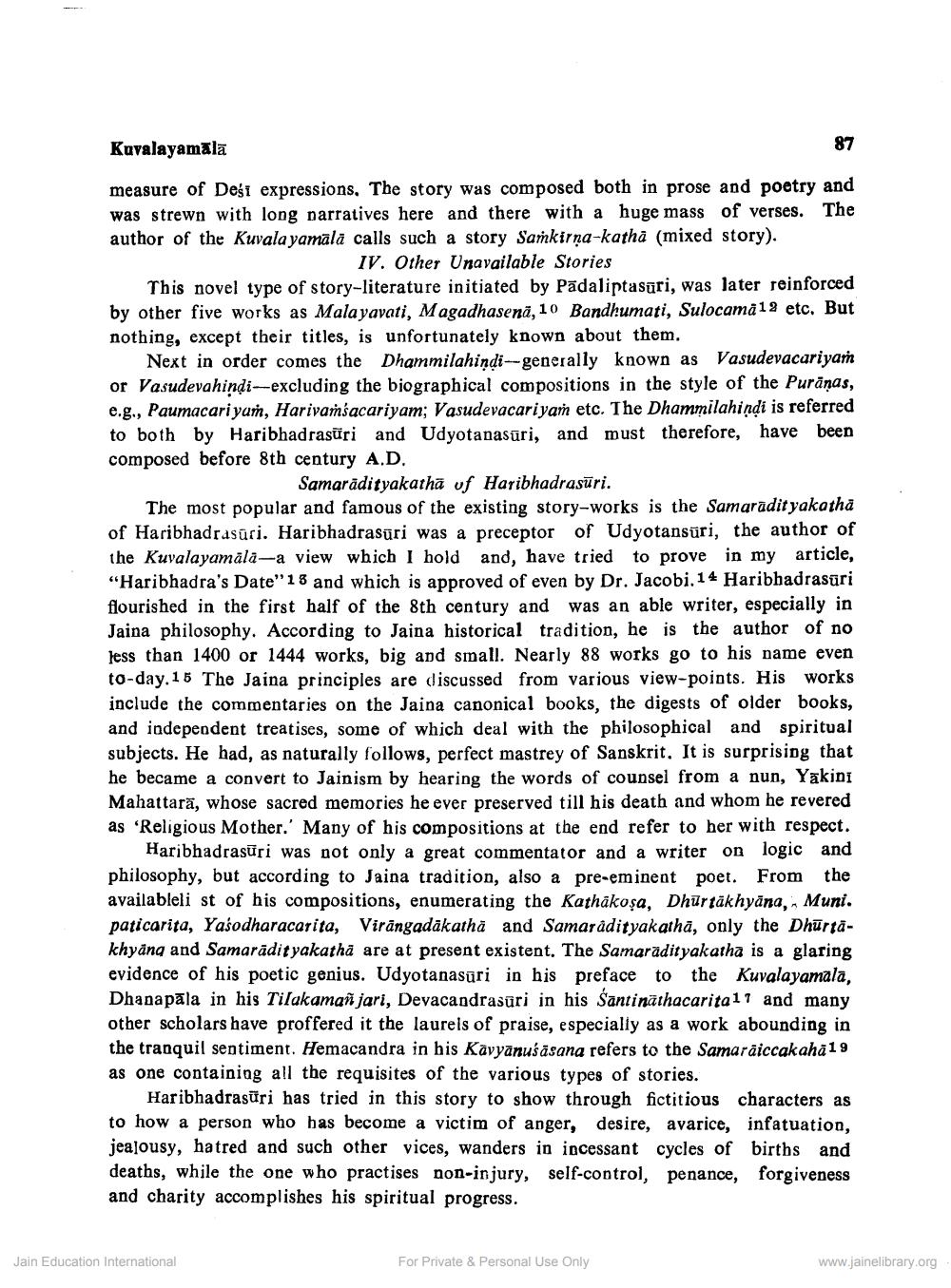________________
Kavalayamala
measure of Desi expressions. The story was composed both in prose and poetry and was strewn with long narratives here and there with a huge mass of verses. The author of the Kuvala yamala calls such a story Samkirņa-katha (mixed story).
IV. Other Unavailable Stories This novel type of story-literature initiated by Padaliptasūri, was later reinforced by other five works as Mala yavati, Magadhasena, 10 Bandhumati, Sulocama12 etc. But nothing, except their titles, is unfortunately known about them.
Next in order comes the Dhammilahindi--generally known as Vasudevacariyam or Vasudevahindi-excluding the biographical compositions in the style of the Purānas, e.g., Paumacari yum, Harivamsacariyam; Vasudevacariyam etc. The Dhammilahindi is referred to both by Haribhadrasűri and Udyotanasūri, and must therefore, have been composed before 8th century A.D.
Samarādityakatha of Haribhadrasūri. The most popular and famous of the existing story-works is the Samaradityakatha of Haribhadrasuri. Haribhadrasūri was a preceptor of Udyotansūri, the author of the Kuvalayamåla-a view which I hold and, have tried to prove in my article, "Haribhadra's Date"18 and which is approved of even by Dr. Jacobi. 14 Haribhadrasuri flourished in the first half of the 8th century and was an able writer, especially in Jaina philosophy. According to Jaina historical tradition, he is the author of no less than 1400 or 1444 works, big and small. Nearly 88 works go to his name even to-day.15 The Jaina principles are discussed from various view-points. His works include the commentaries on the Jaina canonical books, the digests of older books, and independent treatises, some of which deal with the philosophical and spiritual subjects. He had, as naturally follows, perfect mastrey of Sanskrit. It is surprising that he became a convert to Jainism by hearing the words of counsel from a nun, Yakini Mahattara, whose sacred memories he ever preserved till his death and whom he revered as 'Religious Mother.' Many of his compositions at the end refer to her with respect.
Haribhadrasūri was not only a great commentator and a writer on logic and philosophy, but according to Jaina tradition, also a pre-eminent poet. From the availableli st of his compositions, enumerating the Kathākosa, Dhurtākhyāna, , Muni. paticarita, Yasodharacarita, Virāngadākatha and Samarádityakathā, only the Dhurtakhyāna and Samarādityakatha are at present existent. The Samaradityakatha is a glaring evidence of his poetic genius. Udyotanasūri in his preface to the Kuvalayamala, Dhanapāla in his Tilakaman jari, Devacandrasuri in his Šantināthacarita 17 and many other scholars have proffered it the laurels of praise, especially as a work abounding in the tranquil sentiment. Hemacandra in bis Kavyānuśäsana refers to the Samaräiccakaha19 as one containing all the requisites of the various types of stories.
Haribhadrasūri has tried in this story to show through fictitious characters as to how a person who has become a victim of anger, desire, avarice, infatuation, jealousy, hatred and such other vices, wanders in incessant cycles of births and deaths, while the one who practises non-injury, self-control, penance, forgiveness and charity accomplishes his spiritual progress.
Jain Education International
For Private & Personal Use Only
www.jainelibrary.org




